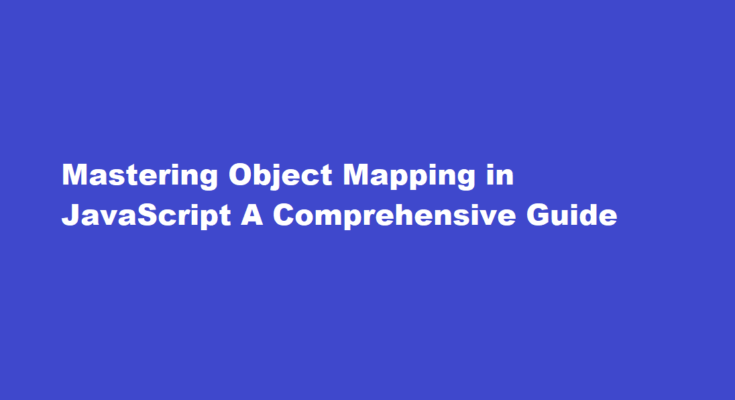Introduction
Object mapping is a fundamental concept in JavaScript that allows developers to transform and manipulate data structures effortlessly. By employing this technique, you can streamline complex operations, enhance code readability, and create more efficient programs. In this article, we will delve into the intricacies of object mapping and provide you with actionable insights to become a mapping maestro.
Understanding Object Mapping
Object mapping involves converting data from one format to another while applying specific rules or transformations. In JavaScript, it’s a versatile technique used extensively in scenarios like formatting API responses, processing database records, or rendering UI components. Mapping is accomplished using functions that iterate through the original dataset, applying desired changes, and returning a new dataset.
The Core of Object Mapping: Callback Functions
At the heart of object mapping lie callback functions. These functions define how the transformation should be carried out for each element in the original dataset. Commonly used callback functions include `map()`, `filter()`, and `reduce()`. The `map()` function, for instance, iterates through each item in an array, applies the provided transformation, and returns a new array with the transformed items. This is invaluable for maintaining the immutability of data.
Example – Mapping to Extract Values
Let’s say you have an array of user objects with names, and you want to extract an array containing just the names. Using the `map()` function, you can achieve this in a concise manner:
“`javascript
const users = [
{ id: 1, name: “Alice” },
{ id: 2, name: “Bob” },
{ id: 3, name: “Charlie” }
];
const names = users.map(user => user.name);
console.log(names); // Output: [“Alice”, “Bob”, “Charlie”]
“`
Advanced Mapping Techniques
Object mapping isn’t limited to simple extractions. It can involve complex transformations, such as combining data from multiple sources or calculating derived values. Utilizing the `map()` function within a `reduce()` operation can be a powerful approach in such cases. This allows you to accumulate and manipulate data while adhering to functional programming principles.
Error Handling and Edge Cases
While object mapping is a potent tool, it’s essential to account for potential errors or unexpected data. Ensure your callback functions are robust enough to handle diverse scenarios. Utilize techniques like optional chaining and default values to prevent your program from breaking due to unexpected data structures.
Performance Considerations
Efficiency plays a pivotal role in coding practices. Although object mapping is convenient, excessive use can impact performance, especially with large datasets. Strive for a balance between readability and performance. If performance becomes a concern, consider alternative approaches like iterating manually using traditional loops.
FREQUENTLY ASKED QUESTIONS
Can we map an object in JavaScript?
To convert an object to a Map , we can call the Object. entries() method with the object as an argument, and pass the result to the Map() constructor to create the Map object. For example: const obj = { user1: ‘John’, user2: ‘Kate’, user3: ‘Peter’, }; const map = new Map(Object.
How to use map method with object in JavaScript?
How to Use JavaScript’s Map() Method to Solve Breadth-First and Depth-First Search Problems. The JavaScript map() method is an object with a key and value pair. An object’s key and value are connected using a colon (:) while the key and value of a map are connected using an arrow (=>).
Conclusion
Object mapping is a transformative technique that empowers JavaScript developers to manipulate data seamlessly. Through an understanding of callback functions and creative utilization of techniques like chaining, you can navigate through various data transformation challenges. By honing your object mapping skills, you’ll undoubtedly enhance your ability to write cleaner, more efficient code.
Read Also : Mapping Network Drives A Comprehensive Guide



